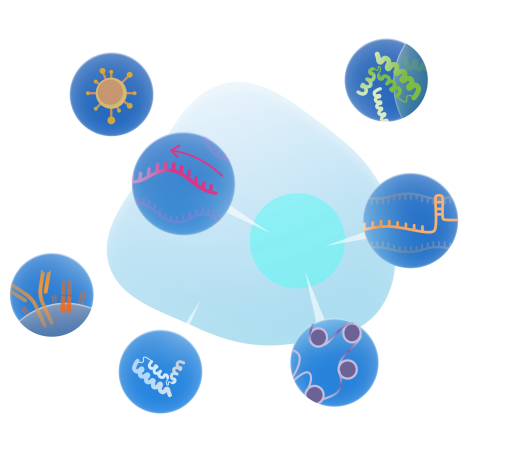
NOW SHIPPING
Flex, reimagined
Plate-based multiplexing has transformed Flex, enabling unprecedented scale. And because it’s powered by Chromium automated cell partitioning, superior performance comes standard. The benefits of plates plus Flex:
- Profile up to 384 samples in a 96-well format
- Run partial plates today, save the rest for later
- Streamline sample handling with automation compatibility
See Chromium Single Cell’s powerful and versatile capabilities in action
Discover how researchers across the globe have used Chromium Single Cell to discover novel cell types and states, understand disease mechanisms, and beyond.
Gene expression
Protein coding gene coverage
Sensitive, robust profiling of 18,000+ genes from human and mouse, even from whole tissue, FFPE samples, and samples with fragmented RNA.
Compatible sample types
Cell suspensions, nuclei suspensions, flow-sorted cells, fixed whole blood, fresh tissue, frozen tissue, FFPE tissue, PFA-fixed tissue, organoids
Whole transcriptome coverage
Profile the whole transcriptome by capturing the 3’ or 5’ ends of mRNA transcripts for unbiased characterization of cell types and states from a wide range of species.
Compatible sample types
Cell suspensions, nuclei suspensions, flow-sorted cells, fixed human PBMCs, fresh tissue, frozen tissue, DSP/Methanol-fixed tissue, organoids
Chromatin accessibility
Chromatin accessibility
Analyze thousands of unique open chromatin fragments per cell, genome-wide, to gain insights into deeper understandings of the cell type–specific regulatory mechanisms.
Compatible sample types
Nuclei suspensions, fresh tissue, frozen tissue
Multiomic profiling
CRISPR
Evaluate gene function across different cellular processes with direct assessment of CRISPR-driven edits or knockdowns and their resulting gene expression phenotypes.
Cell surface protein
Characterize cell subtypes and states more comprehensively with added protein information from the same cell, allowing you to explore transcriptomic and proteomic relationships.
Intracellular protein
Enrich distinct cell phenotype understanding with added protein expression data throughout the entire cell, including nuclear, cytosolic, and secreted proteins.
T cell receptor/B cell receptor
Gain a comprehensive view of the immune system with paired, full-length receptor sequences from T and/or B cells with complete isotype resolution.
Antigen specificity
Obtain comprehensive antigen-specific cellular profiles to identify rare, antigen-reactive T and B cells to fully characterize the adaptive immune response and accelerate therapeutic discovery.
Unique sample prep capabilities
Nuclei isolation from frozen samples
Easily and efficiently prepare frozen samples for single nuclei sequencing, consolidating your experimental processes and improving access to more samples.
Nuclei isolation from FFPE samples
Isolate nuclei from FFPE tissue sections for use with the standard Chromium Gene Expression Flex workflow.
Whole blood fixation
Fix then isolate peripheral blood mononuclear cells (PBMCs) and leukocytes from whole blood upstream of the Flex assay, enabling more flexible and convenient blood-based studies.
Human PBMC fixation
Fix, store, and perform 3’ or 5’ gene expression on human PBMC samples on your schedule, without sacrificing RNA integrity or fragile cell types.
Chop/Fix
Start with whole tissue, chop it into smaller pieces, and then fix prior to dissociation into a cell suspension, preserving fragile cells that would not survive other dissociation methods.
Additional experimental options
Long-read sequencing
Combine long-read sequencing with Chromium assays to identify alternative isoforms and splicing at single cell resolution.
Custom probe design
Target additional mRNAs of interest not covered in the standard Flex transcriptome probe sets, letting you tailor your experiments to your research needs.
Plate-based sample handling
Run up to 384 samples or 100M cells a week with convenient 96-well multiplexing and automation compatibility
